|
|
| Line 296: |
Line 296: |
| | |} | | |} |
| | | | |
| | + | ==Differential Cross Section== |
| | | | |
| | [[DV_RunGroupC_Moller#Moller_Track_Reconstruction]] | | [[DV_RunGroupC_Moller#Moller_Track_Reconstruction]] |
Revision as of 16:58, 2 January 2016
Moller Lund
LUND file with Moller events (with origin of coordinates occurring at each event)
2 1 1 1 1 0 0.000563654 3.53715 0 6.2002
1 -1 1 11 0 0 0.69 -2.4999 10993.7998 10993.80 0.000511 0 0 0
2 -1 1 11 0 0 -0.69 2.4999 6.5852 7.08 0.000511 0 0 0
From a GEMC run WITH the Solenoid ced is used to obtain the information from the eg12_rec.ev file.
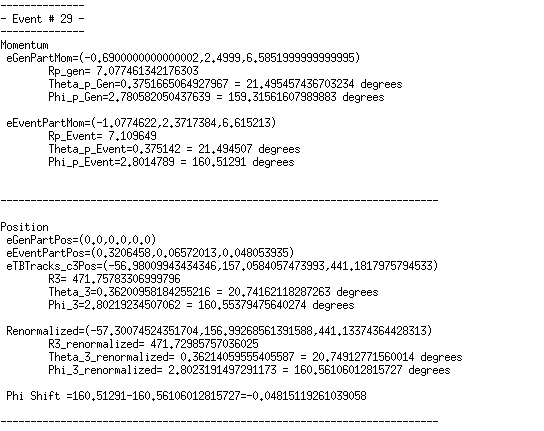
We take the phi angle from the Generated Event momentum as the initial phi angle. The obtain the final phi angle, we can look at the final position of the electron with in the drift chambers.
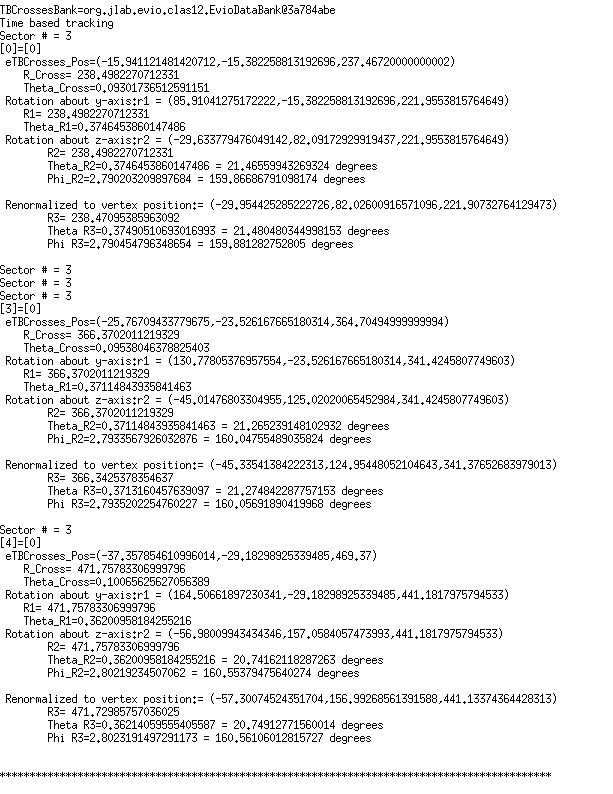
Examining the position from Timer Based Tracking, we can see that after rotations about first the y-axis, then the z-axis transforms from the detector frame of reference to the lab frame of reference.
Euler Angles
We can use the Euler angles to perform the rotations.
For the rotation about the y axis.
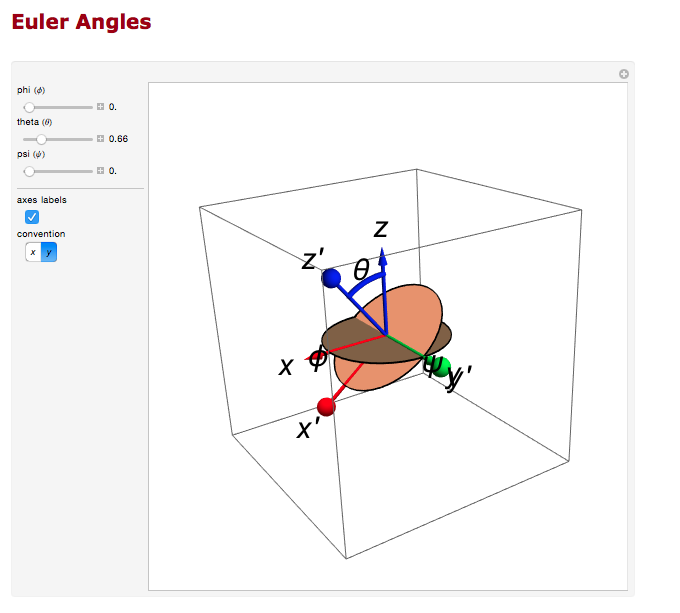
And the rotation about the z axis.
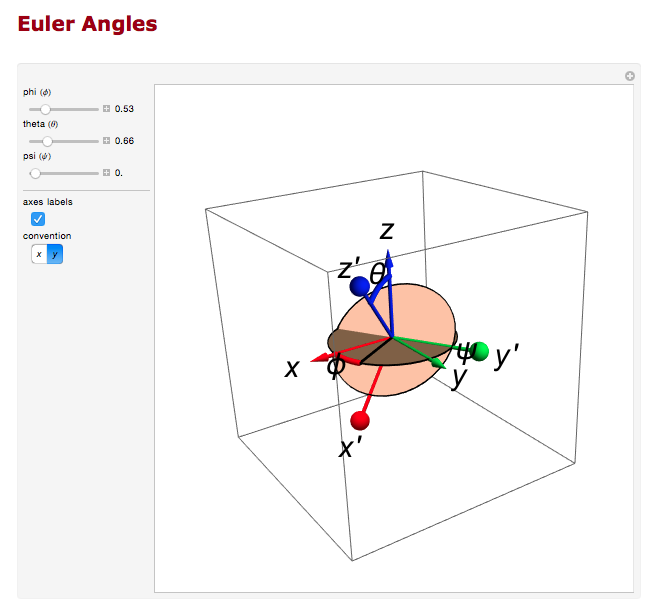
Transformation Matrix
The Euler angles can be applied using a transformation matrix
[math]\left(
\begin{array}{ccc}
\cos (\theta ) & 0 & -\sin (\theta ) \\
0 & 1 & 0 \\
\sin (\theta ) & 0 & \cos (\theta ) \\
\end{array}
\right).\left(
\begin{array}{c}
x \\
y \\
z \\
\end{array}
\right)[/math]
[math]=\left(
\begin{array}{c}
x \cos (\theta )-z \sin (\theta ) \\
y \\
z \cos (\theta )+x \sin (\theta ) \\
\end{array}
\right)[/math]
For event #29, in sector 3, the location of the first interaction is given by
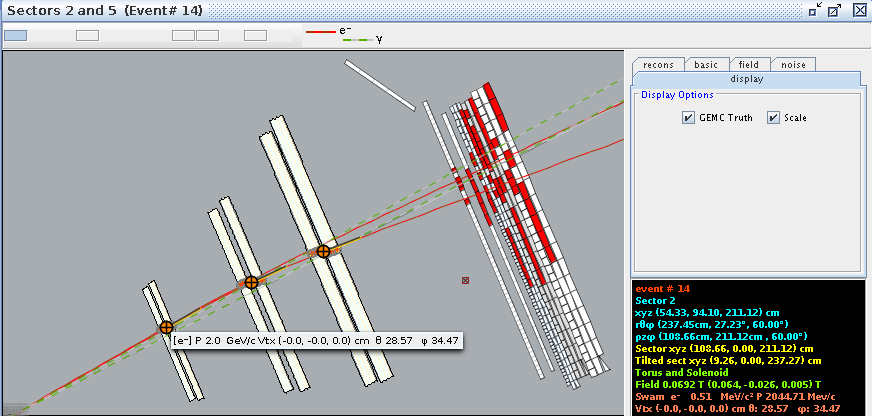
Converting -25 degrees to radians,
[math]\theta =-0.436332[/math]
which is the rotation the detectors are rotated from the y axis.
[math]\left(
\begin{array}{ccc}
\cos (\theta ) & 0 & -\sin (\theta ) \\
0 & 1 & 0 \\
\sin (\theta ) & 0 & \cos (\theta ) \\
\end{array}
\right).\left(
\begin{array}{c}
-15.76 \\
0 \\
237.43 \\
\end{array}
\right)[/math]
[math]=\left(
\begin{array}{c}
86.0588 \\
0. \\
221.845 \\
\end{array}
\right)[/math]
Finding [math]\phi =\frac{120\ 2 \pi }{360};[/math] since "sector -1" =3-1=2*60=120 degrees
[math]\left(
\begin{array}{ccc}
\cos (\phi ) & -\sin (\phi ) & 0 \\
\sin (\phi ) & \cos (\phi ) & 0 \\
0 & 0 & 1 \\
\end{array}
\right).\left(
\begin{array}{c}
86.0588 \\
0. \\
221.845 \\
\end{array}
\right)[/math]
[math]\left(
\begin{array}{c}
-43.0294 \\
74.5291 \\
221.845 \\
\end{array}
\right)[/math]
This shows how the coordinates are transformed and explains the validity of using the TBTracking information to obtain a phi angle in the lab frame.
Phi shifts
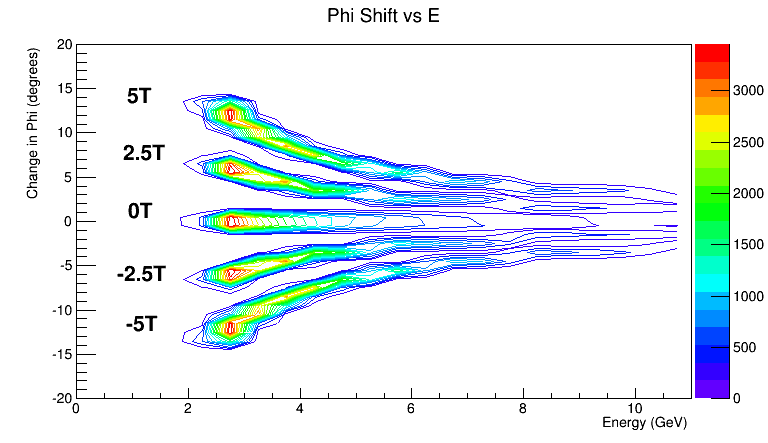
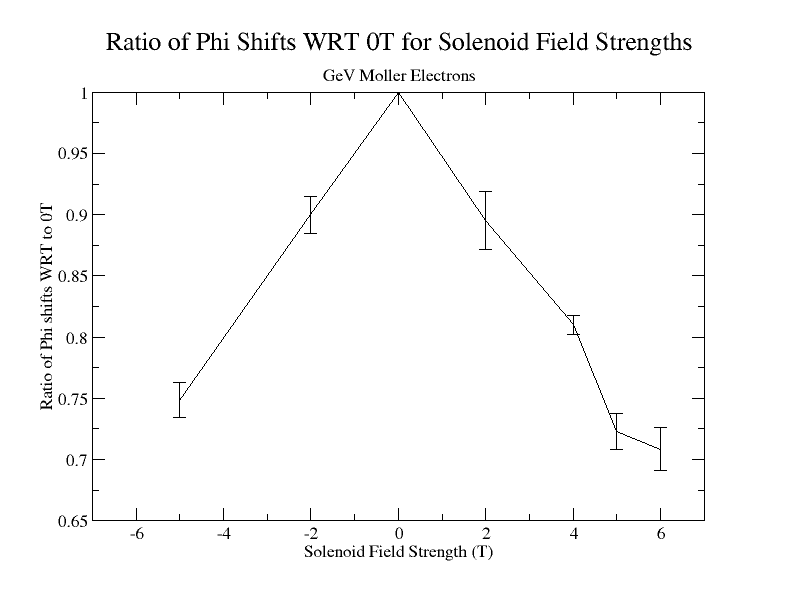
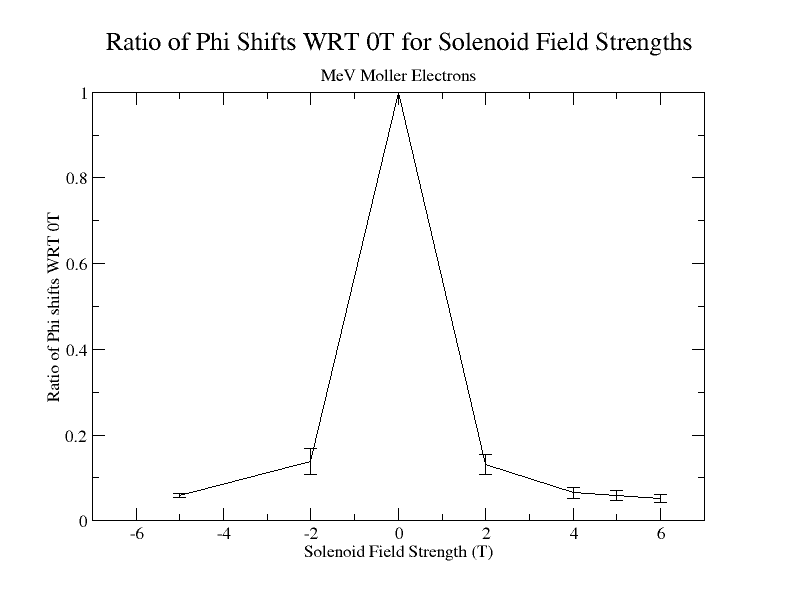
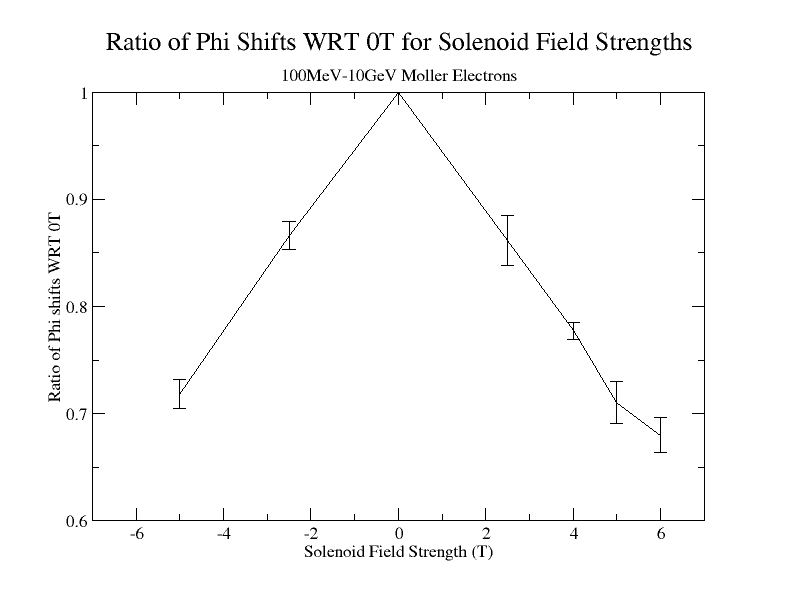
Cross-section Area
Calculations of 4-momentum components
DV_Calculations_of_4-momentum_components
Summary of 4-momentum calculations
| [math]For\ 0 \le \phi \le \frac{-\pi}{2}\ Radians[/math]
|
| x=POSITIVE
|
| y=NEGATIVE
|
| [math]For\ 0 \le \phi \le \frac{\pi}{2}\ Radians[/math]
|
| x=POSITIVE
|
| y=POSITIVE
|
| [math]For\ \frac{-\pi}{2} \le \phi \le -\pi\ Radians[/math]
|
| x=NEGATIVE
|
| y=NEGATIVE
|
| [math]For\ \frac{\pi}{2} \le \phi \le \pi\ Radians[/math]
|
| x=NEGATIVE
|
| y=POSITIVE
|
4 momentum calculations for different frames of reference
| Moller electron Lab Frame
|
Moller electron Center of Mass Frame
|
Electron Center of Mass Frame
|
Electron Lab Frame
|
| [math]p_{2}'\equiv INPUT[/math]
|
[math]p_{2}^*\approx 53.013 MeV[/math]
|
[math]p_{1}^*\approx 53.013 MeV[/math]
|
[math]p_{1}'=\sqrt{E_{1}^{'\ 2}-(.511 MeV)^2}[/math]
|
| [math]\theta_{2}'\equiv INPUT[/math]
|
[math]\theta_{2}^*=\arcsin \left(\frac{p_{2}'}{p_{2}^*}\ sin \left( \theta_{2}'\right) \right)[/math]
|
[math]\theta_{1}^*=\theta_{2}^*+\pi[/math]
|
[math]\theta_{1}'=\arcsin \left(\frac{p_{1}^*}{p_{1}'}\ sin \left( \theta_{1}^*\right) \right)[/math]
|
| [math]E_{2}'=\sqrt{p_{2}^{'\ 2}+(.511 MeV)^2}[/math]
|
[math]E_{2}^*\approx 53.013 MeV[/math]
|
[math]E_{1}^*\approx 53.013 MeV[/math]
|
[math]E_{1}'\equiv E'-E_{2}'[/math]
|
| [math]p_{2(x)}'=\sqrt{p_{2}^{'\ 2}-p_{2(z)}^{'\ 2}} cos(\phi '_2)[/math]
|
[math]p_{2(x)}^*\equiv p_{2(x)}'[/math]
|
[math]p_{1(x)}^*\equiv-p_{2(x)}^*[/math]
|
[math]p_{1(x)}'\equiv p_{1(x)}^*[/math]
|
| [math]p_{2(y)}'=\sqrt{p_{2}^{'\ 2}-p_{2(x)}^{'\ 2}-p_{2(z)}^{'\ 2}}[/math]
|
[math]p_{2(y)}^*\equiv p_{2(y)}'[/math]
|
[math]p_{1(y)}^*\equiv -p_{2(y)}^*[/math]
|
[math]p_{1(y)}'\equiv p_{2(y)}^*[/math]
|
| [math]p_{2(z)}'\equiv p_{2}'\ cos(\theta'_2)[/math]
|
[math]p_{2(z)}^*=\sqrt{p_{2}^{*\ 2}-p_{2(x)}^{*\ 2}-p_{2(y)}^{*\ 2}}[/math]
|
[math]p_{1(z)}^*\equiv -p_{2(z)}^*[/math]
|
[math]p_{1(z)}'=\sqrt{p_{1}^{'\ 2}-p_{(1(x)}^{'\ 2}-p_{1(y)}^{'\ 2}}[/math]
|
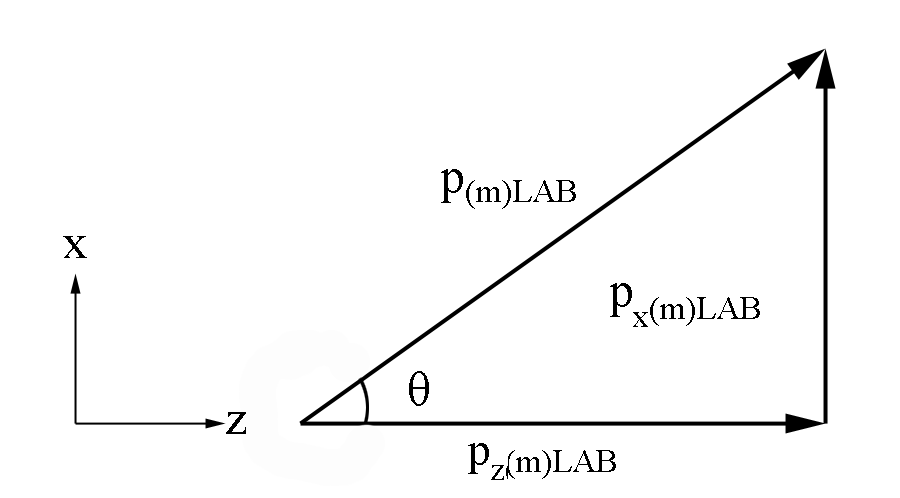
[math]sin \left( \theta_{LAB}\right)=\left(\frac{p_{x(m) Lab}}{p_{(m)Lab}}\right)[/math]
[math]\Longrightarrow p_{(m)Lab}\ sin \left( \theta_{LAB}\right)=p_{x(m) Lab}[/math]
[math]\Longrightarrow p_{(m)CM}\ sin \left( \theta_{CM}\right)=p_{x(m) CM}[/math]
[math]p_{x(m) LAB}\equiv p_{x(m) CM}[/math]
[math]\Longrightarrow p_{(m)CM}\ sin \left( \theta_{CM}\right)=p_{(m)Lab}\ sin \left( \theta_{LAB}\right)[/math]
| [math]\Longrightarrow sin \left( \theta_{CM}\right)=\frac{p_{(m)Lab}}{p_{(m)CM}}\ sin \left( \theta_{LAB}\right)[/math]
|
[math](E_{(e^-) CM}+E_{(m) CM})^2-(\vec p_{(e^-) CM}+\vec p_{(m) CM})^2=s=(E_{(e^-) Lab}+E_{(m) Lab})^2-(\vec{p_{(e^-) Lab}}+\vec p_{(m) Lab})^2[/math]
where previously it was shown
| [math]E_{(m) CM}=E_{(e^-)CM}[/math]
|
| [math] \vec p_{(m) CM}=-\vec p_{(e^-)CM}[/math]
|
| [math] \vec p_{(m) Lab}=0[/math]
|
| [math] E_{(m) Lab}\equiv m_{(m)Lab}[/math]
|
| [math]m_{(m)Lab}=m_{(e^-)Lab}\equiv m[/math]
|
[math](2E_{(m) CM})^2=(E_{(e^-) Lab}+m)^2-(\vec{p_{(e^-) Lab}})^2[/math]
[math]2E_{(m) CM}^2=E_{(e^-) Lab}^2+2E_{(e^-) Lab}m+m^2-p_{(e^-) Lab}^2[/math]
Using the fact,
[math]E^2\equiv p^2+m^2[/math]
[math]2E_{(m) CM}^2=p_{(e^-) Lab}^2+m^2+2E_{(e^-) Lab}m+m^2-p_{(e^-) Lab}^2[/math]
[math]2E_{(m) CM}^2=m^2+2E_{(e^-) Lab}m+m^2[/math]
[math]2E_{(m) CM}^2=2m^2+2E_{(e^-) Lab}m[/math]
[math]2E_{(m) CM}^2=2m(m+E_{(e^-) Lab})[/math]
| [math]\Longrightarrow E_{(m) CM}=\sqrt{\frac{m(m+E_{(e^-) Lab})}{2}}[/math]
|
Differential Cross Section
DV_RunGroupC_Moller#Moller_Track_Reconstruction









